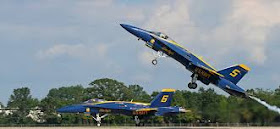an·tic·i·pa·tion
anˌtisəˈpāSH(ə)n/
noun
- the action of anticipating something; expectation or prediction.
Anticipation is a strange word, come to think of it.
Dictionaries describe it as an expectancy of fulfillment of desire. So clearly
it is the expectant reward in the future.
Now let me delve into this futuristic feature, briefly, so
to speak.
There are several layers that bear witness to this
anticipatory reward or outcome. Assume you have just crossed the hold short
line and are turning onto the runway for a takeoff. The anticipation here is
the act of pushing the throttle to the wall and the slow (sometime fast with
afterburners), but progressively increasing acceleration that forces your back
into the leather seat (assuming your aircraft seat has Corinthian leather) and
watching the scenery accelerate away from you as the needle threads its way to
the (blue line in twins) and VSO1.3 in the single four or six banger and you
anticipate the loss of the rumbling noise and the bumpy turbulence of the wheels
on the runway to give way to smoothness and vagaries of the wind and weather. Ah!
Your mind cries, “what an exhilaration!” It happens to me each time sitting in
Seat 10F, 20F or 30A of a commercial jet too; that moment when the surely bonds
of earth do not chain me or the lumbering megaton piece of Aluminum to gravity
and the quiet roar of the jet engine turns into a whine and smoothness takes
over. Ah what a feeling!
So where is the lesson in all this?
Glad, you asked. Here it is! At liftoff, there must be a
certain anticipation of dread that must be encountered as well.
What ifs?
What if the engine should quit on takeoff? What then? Many
an accident has taken the life of the non-curious pilot. What if, is therefore
anticipatory. Of not a reward or the thrill of it but the ignominy of the
workings of a gremlin (or your last mechanic or you in inadequate preflight).
If you anticipate such an eventuality that gremlins do exist, then you are
prepared for the outcome. Landing straight or 30 degree bearing left or right
of the flight path below 700feet on a takeoff, on a single runway airfield, or
reversal of course above 1000 feet. And you must have anticipated where to land
on previous takeoffs where to safely set the aircraft down in case of such an
“anomaly” (as NASA would call it). In fact, it behooves us, as pilots to look
for safe landing zones (at your airport) while entering the traffic pattern. Have
you checked for them? In fact, this should be a routine at any airfield. The
45-degree angling into downwind has its rewards, accept them eagerly.
Anticipation is common to most pilots as it must be to all.
For instance, if you bank the aircraft left or right, there is a loss of the
vertical component of lift, isn’t it? That leads to a dropped altitude, hence
the accompanying action to the bank is a slight pull on the stick (or yoke) to
maintain altitude. But if there is no thrust (as in engine power failure) the
lift component degradation is more significant. Try finding out that altitude
loss at higher altitudes with your instructor- and a wind-milling prop.
Maneuvers practiced at altitude and in controlled environment bring the calm
needed when things go “clink.” That will serve you well in a real calamity.
Oh, and I might as well mention this while I am at it. For
those trained as Instrument Pilots (As I believe all pilots should be for
safety reasons alone) entering the clouds the first time on any flight should
alert one to review the status of all instrument functionalities (In addition
to a thorough prior preflight check on the ground). The Attitude indicator, Airspeed
indicator, the Altimeter etc. Those gauges are all we have when the electronic
or mechanical gremlin tickles its personal fancy to mess with your $200
hamburger flight. If those beautiful TV screens fail, you are left with the
basics as well. Learn to use them well! Scan the steam gauges and the data on
the glass; constantly.
Pilots, Repeat after me, ”Attitude, Altitude, VSI, Airspeed, HIS/Gyro
Heading Indicator, Turn Coordinator” Got it? For Glass lovers, same stuff,
different format.
And sometime other non-discrimatory gremlins can cloud the view as happened
in this F-16 crash at Whittman Field at Oshkosh, WI in 2011 when the canopy got
clouded due to depressurization-environmental issues and the pilot went 300
feet beyond the threshold for a $5 million oops!
So, anticipation is the desirous word for that deliciousness, or not,
yet to come. Some events might not have the same charm to them as
others, but they are all events worthy of note. It is always the prepared
(anticipatory) pilot who learns to enjoy and weather all outcomes equally with
a similar measure of quiet aptitude, attitude and decision-making.
“Live Long (Fly Long) and Prosper” as Spock might have said.


No comments:
Post a Comment